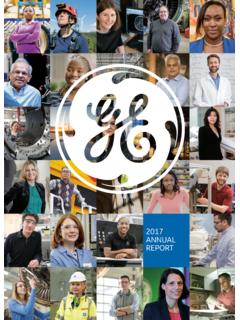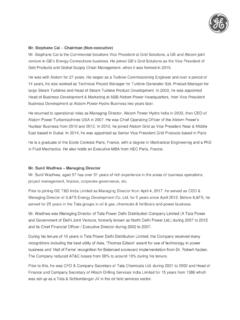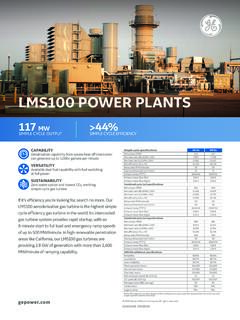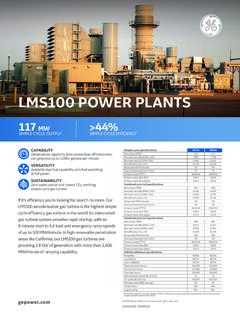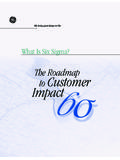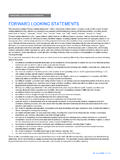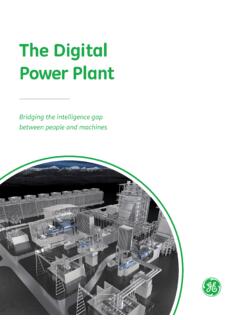Transcription of How GE Teaches Teams to Lead Change
1 HBR AT LARGE. How GE Teaches Teams to Lead Change by Steven Prokesch . Reprint R0901J. This article is made available to you with compliments of GE. Further posting, copying or distributing is copyright infringement. To order more copies go to or call 800-988-0886. HBR AT LARGE. How GE Teaches Teams to Lead Change by Steven Prokesch In October 2007 I attended the four-day pro be genuinely trying to alter their roles and gram Leadership, Innovation, and Growth behavior in order to foster growth. Why was (LIG) at General Electric's famed manage LIG so effective in helping to bring about these COPYRIGHT 2008 HARVARD BUSINESS SCHOOL PUBLISHING CORPORATION. ALL RIGHTS RESERVED. ment development center in Crotonville, New changes? There were ve main reasons: York. LIG was the rst effort in the center's team training accelerated the pace of 51-year history to bring all the senior members Change by giving managers an opportunity to of a business's management team together for reach consensus on the barriers to Change and training.
2 Launched in 2006, the program had how best to attack them. a speci c purpose: to support CEO Jeffrey R. Participants were encouraged to consider Immelt's priority of growing GE by focusing both the hard barriers to Change (organiza . more on expanding businesses and creating tional structure, capabilities, and resources). new ones than on making acquisitions. and the soft (how the members of the leader . As a senior editor at HBR, I was invited to ship team individually and collectively behave go through LIG with 19 senior managers of and spend their time). GE Power Generation, one of the company's The eternal management challenge of oldest businesses. (It dates back to the days of balancing the short term and the long term . Thomas Edison.) About a year later I revisited or simultaneously managing the present and the turbine heads, as Immelt affectionately creating the future was explicitly addressed. calls them, to see how much impact the pro Beyond providing new concepts that gram had made.
3 The answer was plenty: The would make people look at their businesses business had accelerated its push into emerg and themselves differently, the course created a ing markets, launched initiatives to revamp common vocabulary of Change literally words product development, and stepped up efforts that became part of daily communications to create new businesses. Managers seemed to inside and across GE's businesses. harvard business review january 2009 page 1. This article is made available to you with compliments of GE. Further posting, copying or distributing is copyright infringement. To order more copies go to or call 800-988-0886. How GE Teaches Teams to Lead Change HBR AT L ARGE. The program was not an academic exer The reality, I learned, was that headquar . cise; it was structured so that a team would ters was the main force behind GE's successes. emerge with the rst draft of an action plan for Immelt understood that to speed progress, he instituting Change in its business and would needed to pass the baton to the Teams leading feel obligated to deliver on it.
4 GE's businesses which is where LIG came These principles which can be applied to in. As he explained in the company's 2007 an . the design of any Change -management pro nual report, the program's aim was to embed gram, not just one concerning growth are growth into the DNA of our company. By the focus of this article. that he meant getting the Teams leading the businesses to think about organic growth day The Need for LIG in and day out to be constantly on the look . As I drove to Crotonville to attend Leadership, out for opportunities and to create inspira . Innovation, and Growth that October, I won tional strategic visions that would enlist their dered why such a program was even necessary. troops in the cause. He wanted them to weave Shortly after becoming CEO, in September innovation and growth into every aspect of 2001, Jeff Immelt had launched an all-out ef their businesses. He didn't just want these fort to make GE as renowned for innovation managers to reexamine their capabilities, pro.
5 And organic growth as it was for operational cesses, metrics, organizational structures, and excellence the hallmark of his predecessor, deployment of resources. He wanted them to Jack Welch. The company seemed to be mak reconsider how they individually and collec . ing superb progress: GE's revenues, exclusive tively led: their behavior, their roles, how they of acquisitions, would increase by 9% in 2007, spent their time. In short, the purpose of LIG. marking the third consecutive year the com was to make innovation and growth as much pany had met or surpassed Immelt's goal of of a religion at GE as Six Sigma had been growing organically at two or three times the under Jack Welch. pace of global GDP. Initiatives such as eco . magination (developing solutions to clean The Structure water and energy issues) and imagination The brainchild of Susan P. Peters, GE's vice breakthroughs (stretch ideas with the poten president of executive development and chief tial to become $1 billion businesses) had lived learning of cer, and Daniel S.
6 Henson, then up to their catchy names; they were already the company's chief marketing of cer and producing billions of dollars in revenues. now the president of GE Capital Solutions, Rapidly expanding activities in emerging mar LIG began in September 2006 and ended in kets would generate $ billion in revenues September 2008. (A follow-up program, to be in 2007, which would help push sales outside launched in 2009, is in the works.) Altogether the United States to more than half of GE's 2,500 people in 260 Teams went through the total for the rst time. program. There were six Teams at the session Initially I assumed that these successes had I attended: GE Power Generation, one of the resulted from fundamental changes in GE's world's largest manufacturers of equipment internal machinery. Substantially higher and for producing electricity; GE Healthcare's much more focused R&D spending had diagnostic imaging unit; NBC Universal's greatly increased the ow of technology from sales group; and three nancial services GE's laboratories.
7 Thousands of marketers businesses GE Money's Nordic and Baltic had been hired to bring more external focus operation, GE Capital Solutions Europe, and to businesses. The growth imperative had GE Corporate Financial Services Europe. been woven into core processes such as the Before a team went to Crotonville (or some . annual strategic review (renamed the growth times another site in the case of smaller busi . playbook ) and the annual HR review, when ness units), it had done three things: It had managers are assessed on their growth updated its three-year strategy, the growth values traits that GE had identi ed as playbook. All its members had undergone a necessary to create new businesses and ex 360 review, and the team 's scores on the Steven Prokesch (sprokesch@ pand into new markets. (See Growth as a growth values had been tabulated and ana . ) is a senior editor Process, an interview with Jeff Immelt, HBR lyzed in granular detail.)
8 Finally, its success at HBR. June 2006.) in creating an innovative climate had been harvard business review january 2009 page 2. This article is made available to you with compliments of GE. Further posting, copying or distributing is copyright infringement. To order more copies go to or call 800-988-0886. How GE Teaches Teams to Lead Change HBR AT L ARGE. assessed. (See the exhibit Attributes of an HR process helps individuals identify growth Innovative Organization. ) values in need of improvement and prescribes The speakers at my session were a blend of training, it fails to recognize the fact that the external gurus (mostly from leading busi other members of their Teams might have ness schools) and internal thought leaders or differing notions. For example, someone who role models who could demonstrate how the needs to become more inclusive might be on a concepts had been or were being applied at team that doesn't highly value a collegial style GE.
9 We realized that when you're talking or isn't interested in sharing information about capabilities and culture, you have to broadly. In that environment the individual connect the dots with the GE folks because it might nd it dif cult to Change his or her can't be abstract, Henson told me. ways. Three internal examples were presented. The same is true for new ideas or tech . One the transformation of GE Transporta niques. For example, GE has been teaching its tion from a mature, highly cyclical North marketing and sales folks customer segmenta . American locomotive business into a fast- tion methods as part of an effort to make the growing, diversi ed global transportation company more customer focused. But upon company was a dramatic success. But the returning to their businesses, many of these two others customer segmentation in GE people have been frustrated in their attempts Oil & Gas, a business that provides equip to implement what they learned, because ment and services to the energy industry, and managers who had not attended that training sales management and compensation in GE didn't understand or value the effort.
10 Capital Solutions came across as works in This explains why the entire afternoon of progress, which surprised me. When I asked my day two was devoted to customer segmen . Peters about this, she explained, Cases used tation. A lecture by David Reibstein, of the at Crotonville are always works in progress. University of Pennsylvania's Wharton School, The LIG sessions are about reality. seemed pretty basic for a company of GE's After listening to the experts lecture on top sophistication. But Stephen R. Bolze, the presi . ics related to strategy, capabilities, and culture, dent of Power Generation, explained to me the management Teams dispersed to separate that it was probably not basic for people in rooms. There, in brutally frank and free- functions such as manufacturing, who don't owing conversations, they shared their take regularly interact with customers. In their aways and debated the implications for their quest for high quality, ef ciency, and low costs, businesses and the way they led.

